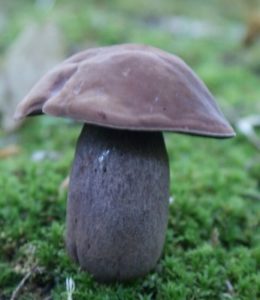Every year the Northern New England Poison Center helps patients who have become sick after misidentifying mushrooms they picked to eat. Among NNEPC cases, mistakes made while foraging are the second most common cause of serious mushroom poisonings, behind only people who become sick after taking psychedelic mushrooms on purpose.
Foraging mistakes don’t just happen among people who are new to mushroom gathering. Many of our cases involve people who have been foraging for years.
What are some mushrooms that cause poisonings in our area?
The most common case of mistaken mushroom identity we handle at the NNEPC involves the poisonous jack o’lantern mushroom (Omphalotus illudens), which can be mistaken for edible golden chanterelles (Cantharellus cibarius). Other poisonous lookalikes that are common problems in our region include:

The lilac brown bolete is a toxic mushroom, sometimes mistaken for the edible king bolete. Photo courtesy of Greg A. Marley.
- The lilac brown bolete (Tylopilus eximius), mistaken for the edible king bolete (Boletus edulis complex)
- The false morel (Gyromitra esculenta), mistaken for the yellow morel (Morchella esculenta)
- The pigskin puffballs (species within Scleroderma), mistaken for edible puffballs (various species within Calvatia and Lycoperdon)
What symptoms do poisonous mushrooms cause?
Most poisonous mushrooms are stomach irritants and cause symptoms like stomach ache, vomiting, cramps and/or diarrhea, which can sometimes be severe. These usually appear within 30 minutes, though they may take longer.
However, more dangerous mushrooms do not cause symptoms for 6 hours or longer after eating them. While these poisonings may also start with stomach cramps and diarrhea, they can lead to more severe effects. These can include seizures or damage to your liver or kidneys. Most patients recover with hospital care, but these effects can be fatal.
What should I do if someone gets sick after eating a wild mushroom?
- Call the poison center right away at 1-800-222-1222. The poison center can help identify the mushroom and determine what treatment is needed.
- If possible, take some pictures of the mushroom or one just like that you can send to the poison center. Take one picture showing the side view of the mushroom next to a ruler, coin, pen or other object to show the size. Take another picture showing underneath the mushroom’s cap, and one from the top.
- Information about where the mushroom was growing can also help the poison center—on wood or out of the ground, in the forest or on the lawn, etc.
How can I prevent poisonings from foraging?
Foraging always carries some risk. Even people who have been doing it for years can make mistakes or have unexpected reactions. Avoiding foraging is the only way to be 100% safe.
If you are going to forage, take some training from an expert first. The North American Mycological Association has a list of mushroom clubs, including ones in Maine and New Hampshire, that may have information on available trainings. A training should cover not just identification, but also safe storage and cooking.
If you have recently been poisoned by a wild mushroom, you can help prevent future mushroom poisonings by submitting a report about your experience to the North American Mycological Association Poison Case Registry.




